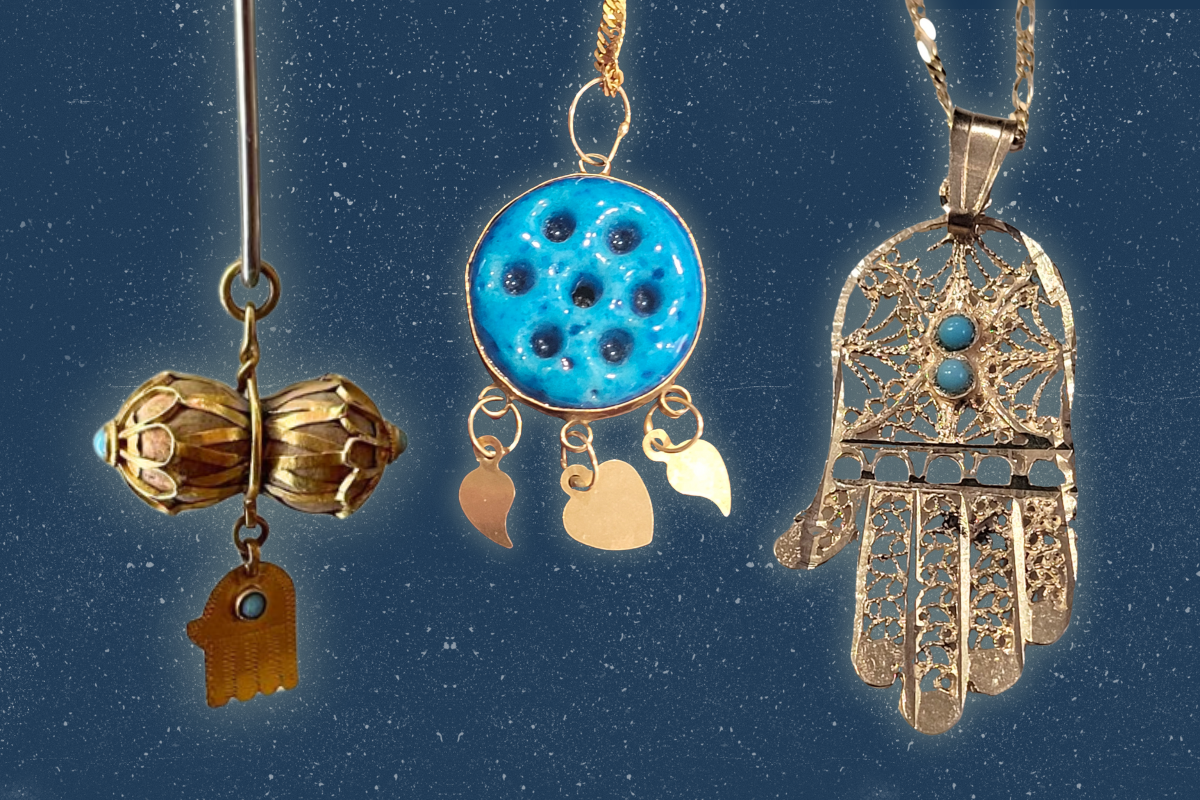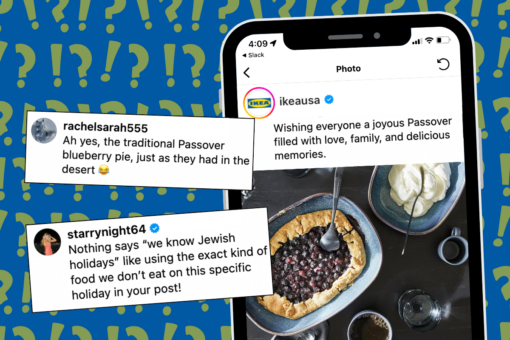I grew up in London in an immigrant family of Middle Eastern and Indian Jews and let me tell you, we took our amulets and the idea of the evil eye very seriously!
We were taught that you should be careful what you say. When you brag about your accomplishments, you are inviting the evil eye to look at you. If you announce a pregnancy too early, the unthinkable may occur. When you draw attention to yourself, no good can come of it. There is the chance that it could all be taken away. The use of amulets comes from the belief that bad thoughts and jealousy from another — intentional or unintentional — can inflict harm on a person. Amulets help protect and deflect this evil eye. I felt absolute, unquestionable love from my parents and grandparents, but there wasn’t much praise or lauding of accomplishments. My grandfather would quietly tell me that I was the apple of his eye but dismiss compliments aimed at me from distant relatives. Somehow, I felt that my parents were proud of me without them actually saying it. Celebrating achievements publicly might lead to bad things.
Now, if you believe in the power of the evil eye, (and I really do!) you need something to protect yourself from it. For thousands of years, people of all religions in many parts of the world have used amulets to protect themselves from misfortune and bad luck. Although it seems like mere superstition and not very Jewish, these amulets and the belief in the evil eye are based in the Torah and in Rabbinic texts. For example, the Priestly Blessing (Numbers 6:24-26) was considered effective protection against the evil eye. In the Talmud (Bava Batra 2b:9) the rabbis tell us that we may not stand in another person’s field and look at it while the grain is standing. Intentionally or otherwise, we may cast an evil eye on it and cause the crop to fail. A bride’s veil in a Jewish wedding is said to serve as a barrier between her and any jealousy or bad intentions.
Historically, each amulet has a specific purpose. It may be to keep babies safe, ease childbirth, ensure a swift recovery from illness, protect one’s livelihood, bring on fertility or encourage a successful marriage. In the modern world many are made for general protection.
Here are just three of the many amulets that I grew up with.
Hamsa
Everyone knows the hamsa. You can buy anything with a hamsa on it: jewelry, t-shirts, cushions, wall-hangings. When I wanted to give a fridge magnet hamsa as a party favor at my wedding, my mother would not allow it. I felt it would be an acknowledgement of my heritage but I didn’t really understand its meaning and its uses. My mother explained that by giving them out at a wedding, you are telling your guests that you need a hamsa to keep their ayin ha’ra (evil eye) away from you! You’re saying that you believe it’s possible that they may wish you harm and that you need something to protect your family from their jealousy or ill wishes. Growing up, hamsas were used in specific ways: worn around the neck, diagonally across the body on a chain, or placed near the door of the home.
In the Torah, we read the Exodus story. God takes the people of Israel out of Egypt “with a strong hand and an outstretched arm” (Deuteronomy 5:15). The image of the “strong hand” is a metaphor for the power of God, a Divine power taking care of the Jewish people. There is also the numerical link between the number five, the letter hey, and the hamsa, which means five in Arabic (just as in Hebrew the word for five is chamesh). Hey is the fifth letter of the aleph bet and the single-letter name of God.
Seba Ayoun
Seba ayoun literally means seven eyes. Why use just one eye to ward off evil when you can have seven? Seba ayoun is basically a blue ceramic circle with seven holes representing eyes. These holes are said to have the power to divert the evil eye and send it in multiple directions, causing it to lose its negative energy. It is blue because of the belief that water has the ability to absorb the rays of the evil eye. This is also the reason many traditional hamsas have a turquoise stone. The original source of seba ayoun is unknown, but it is thought to come from the ancient Babylonians, around 5,000 years ago. In my family, seba ayoun is an amulet specifically used for the wellbeing of babies. It is usually attached to the crib or clothing of the baby, along with a clove of garlic.
Afsa
Afsa is another amulet whose sole purpose is to protect the mother in childbirth and keep the evil eye away from babies. It consists of two small balls made of cedarwood which are wrapped nine times with a thin gold strip. Often, there will also be a small hamsa, a turquoise stone, a clove of garlic or a wolf tooth on the afsa. My grandmother had quite a few of them, each one slightly different. Every time someone in the family had a baby (and we are a BIG family!), she would take one out and give it to the mother before the birth. They would be passed along among her children and later her grandchildren and her great grandchildren. Once the baby began to crawl, the afsa would go back to my grandmother, or to the next mother-to-be.
Although I try to break with the family tradition of not praising my children enough and deflecting compliments, I am aware that old habits are hard to break. I kiss them (when they let me!) and call them, “Ayouni” (Judeo-Arabic for “my eyes,” to indicate how truly precious they are to me). But then I jokingly tell them that they are annoying and underachievers. If someone tells me one of them is beautiful, I say, “Yes, but her hair is so messy,” or something of the sort. I try not to show-off about their achievements (although it’s sometimes hard!). I know it sounds odd but it’s instinctive, to deflect the evil eye and keep it at bay. And if something slips through, well… there’s an amulet for that.



